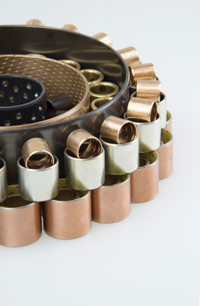
Posted to News on 25th Jun 2018, 00:00
Plain bearings versus rolling element bearings
Craig Clydesdale of Bowman International explores the various benefits of plain bearings and analyses whether they really are a viable replacement for rolling element bearings.

Until recently rolling element bearings enjoyed an unrivalled dominance in many applications and products. The traditional view of plain bearings was that they were ineffective and unable to take the same load. High load and high-speed applications were the domain of the rolling element. However we are increasingly seeing plain bearings replacing rolling element bearings in a wide range of products including turbines, pumps and equipment for agriculture and construction, as design engineers learn that plain bearings’ design simplicity has advantages.
One advantage that attracts project managers, design engineers and buyers alike is, of course, cost. Tooling of complex, multi-component rolling element bearings is expensive in comparison to plain bearings. The simplicity of design, ease of tooling and simple construction of plain bearings lends itself to being a much more cost-effective solution. This also makes them far lighter than rolling element bearings. This is a boon to many design engineers who are constantly looking to save weight anywhere they can. We are seeing more and more design engineers from the automotive and aerospace sectors switching to plain bearings for this very reason.
Because rolling element bearings are complex, multi-component parts they have a much larger section area than plain bearings. They consist of four main parts: the outer race, the rolling element, the cage and the inner race. Plain bearings, in contrast, are essentially comprised of a single layer of metal, plastic, or a combination thereof, or a composite material. Removing the necessity to accommodate such a large part saves a significant amount of space and weight which in many applications is a precious commodity.
The much larger wetted area of plain bearings was traditionally seen as a disadvantage. A larger contact area meant friction, and friction was certainly not a trait you would want associated with high speed applications. However, with the advent of self-lubricating and oilless plain bearings this issue has become somewhat cured and the larger surface-contact area can now be seen as an advantage; designers are able to save space and cost by using smaller plain bearings that can accommodate greater loads.
Because of these properties, plain bearings also better withstand shock loads which often cause fatigue damage and brinelling in rolling element bearings. An apt analogy would be stiletto heels versus flat soled shoes; worn by the same person the stiletto heels will cause damage on some flooring but the flat-soled shoes will not. The same principal applies to the load spreading in plain bearings in comparison to rolling element bearings.
Shaft misalignment is another factor that can often put roller element bearings at a disadvantage. Because load is concentrated on a narrow contact area, shaft misalignment can cause increased wear and shorten life unless the bearing has been specifically designed to compensate. Misalignment is not such an issue for plain bearings as they distribute loads evenly across the increased contact-surface area.
Noise levels are always a concern that designers need to address. Rolling element bearings can be noisy; this is a simple fact. They become even more noisy as they wear or and the lubricant migrates. Misalignment will cause vibrations which translates into noise which is then further amplified by adjacent parts within the assembly. Plain bearings have no moving parts. There is nothing to cause any audible noise. The layered structure of some of today’s plain bearings actually serves to absorb vibrations, which means less noise from bearing and shaft interaction.
Another industry in which we are seeing growing demand for plain bearings that were traditionally the domain of rolling element is the agricultural sector. Applications within the agricultural sector are generally industrial and heavy duty and require a solution that can withstand extremely high loads, shock loads, lack of lubrication and have excellent anti-corrosion properties.
One of the biggest issues faced by rolling element bearing manufacturers is dirt and moisture contamination and the migration of the lubricant the constant battle is to improve the seal design to guard against these problems. It has been said that rolling element bearings are only as good as their seal; the moment the seal is compromised, the bearing is obsolete and needs to be replaced.
This is particularly relevant in agricultural sector, and Bowman International’s latest innovation seeks to address this problem by replacing the rolling element bearings within the hubs with its unique, heavy duty spinodal bronze BowMet range of plain bearings. BowMet bearings were specifically developed in 2015 for heavy duty applications that other bearings could not handle. Their load, heat, speed, low coefficient of friction and corrosion capabilities combine to offer a solution that can stand up to the harshest conditions. In replacing rolling element bearings with BowMet bearings, dirt contamination becomes far less of a problem. The dirt can pass through the unit and out again without causing any significant damage.
A typical farm requires 20-30 days tillage in spring and 10-20 days tillage in autumn. At present it is accepted that a farmer will need to replace the agri hubs on his plant at least once a year, but more likely once a season. When you consider that there are around 60 to 120 hubs on a typical harrow or seeder, it is easy to see that this quickly turns into an extremely expensive endeavour. Replacing traditional rolling element bearings with BowMet bronze bearings indicates a step change in the design concept of agri hubs, and can significantly increase the life expectancy of the hubs.
It would be reductive, and indeed incorrect, to suggest that plain bearings can replace rolling element bearings across the board. There remain applications where rolling element bearings really are the only solution. However, the simplicity of design, the cost-effectiveness, the increased reliability and the low levels of maintenance of plain bearings are beginning to steal a march on rolling element bearings as designers look to streamline their projects and reduce costs.
Bowman International Ltd (incorporating Oilite Bearings)
10 Isis Court, Wyndyke Furlong
Abingdon Business Park
OX14 1DZ
UNITED KINGDOM
+44 (0)1235 462500








